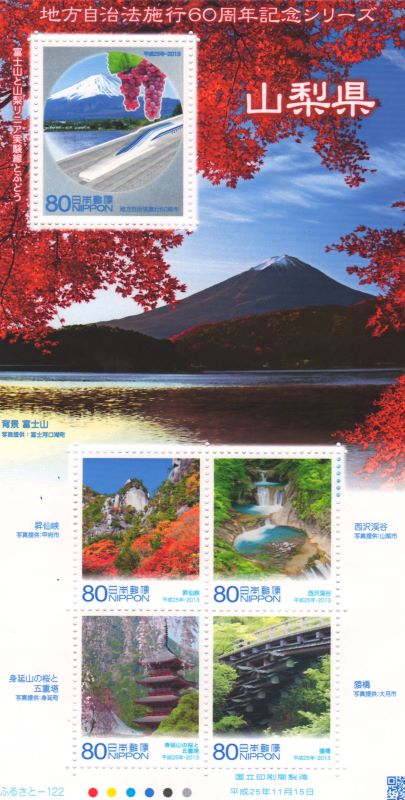WORLD BUDDHIST STAMPS e.GALLERY
bringing the buddhist world at the comfort of your home
| 60th Anniversary Series of Local Autonomy Law Enforcement Yamanashi Prefecture | |
Stamps illlustrations:
1. Mt. Fuji: It is a mountain that represents Japan, and its altitude is 3,776m, which is the highest peak in Japan. It has been worshiped as an object of worship since ancient times, and as a source of art, it has produced various works of art such as paintings. It was registered as a World Cultural Heritage site in June 2013.
2. Yamanashi Maglev Test Line: Japan's only maglev test line for linear motor cars. It was laid in the eastern part of Yamanashi prefecture, and the running test started in 1997 (Heisei 9).
3. Grape (Koshu variety): It is said to be a variety native to Japan with a history of 1300 years, and was cultivated in the Katsunuma area. Currently, it is cultivated for raw consumption and wine in various parts of the prefecture. The harvest season is from mid-September to late October.
4. Shosenkyo: It is said that Kakuen, the main peak of the Shosenkyo, which boasts the most beautiful valley in Japan, was trained at the summit of a few tatami mats in the olden days.
5. Nishizawa Valley: Nishizawa Valley is located in Chichibu Tama Kai National Park and is a scenic spot that boasts one of the most beautiful valleys in Japan.Like the natural art of clear streams eroding huge granite, the mountain streams that flow through the primeval forest create a number of waterfalls, full of mysterious charm.
6. Cherry blossoms and five-storied pagoda in Minobu: The area around Kuonji Temple in Minobu is one of the most famous cherry blossom viewing spots in Japan. Among them, the weeping cherry tree at Kuonji Temple in Minobu is 400 years old, and the appearance of the cherry blossoms hanging on the ground is very spectacular.
7. Saruhashi: It is one of the three strange bridges in Japan along with "Kintai Bridge in Iwakuni" and "Kiso no Ki". Its appearance, which is 30.9m long, 3.3m wide and 31m high, is a special one that does not use piers at all, and is supported by four layers of green onions that overhang from both banks that rise sharply. |
|
| Issued Country | Japan |
| Issued Year | 2013 |
| Category | Buddhist Architect Events Buddhist Arts Buddhist Landscape |
| Type | Commemorative/Special Stamps |
